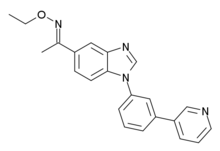NS-2710
 | |
| Identifiers | |
|---|---|
| |
| PubChem CID | |
| Chemical and physical data | |
| Formula | C22H20N4O |
| Molar mass | 356.420 g/mol g·mol−1 |
| 3D model (JSmol) | |
| |
| (verify) | |
NS-2710 (LS-193,970) is an anxiolytic drug with a novel chemical structure, developed by the small pharmaceutical company Neurosearch. It has similar effects to benzodiazepine drugs, but is structurally distinct and so is classed as a nonbenzodiazepine anxiolytic. NS-2710 is a potent but non-selective partial agonist at GABAA receptors, although with little efficacy at the α1 subtype and more at α2 and α3. It has anxiolytic effects comparable to chlordiazepoxide,[1] and while it is a less potent anticonvulsant than the related drug NS-2664, it has a much longer duration of action, and similarly to other α2/α3-preferring partial agonists produces little sedative effects or physical dependence.[2]
References
- ^ Evenden J, Duncan B, Ko T. A comparison of the effects of psychotomimetics and anxiolytics on punished and unpunished responding maintained by fixed interval schedules of food reinforcement in the rat. Behavioural Pharmacology. 2006 Feb;17(1):87-99. PMID 16377966
- ^ Mirza NR, Nielsen EØ. Do subtype-selective gamma-aminobutyric acid A receptor modulators have a reduced propensity to induce physical dependence in mice? Journal of Pharmacology and Experimental Therapeutics. 2006 Mar;316(3):1378-85. PMID 16352707
